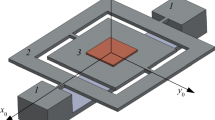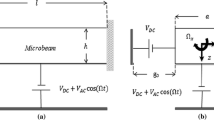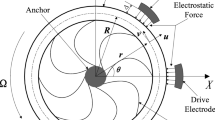Abstract
The singularity analysis on the periodic response of a symmetric comb driving and sensing MEMS gyroscope is carried out in this paper. Considering the nonlinear stiffness of the elastic beams and the nonlinear electrostatic forces of the driving and sensing combs, the dynamic equations are established by using the Lagrangian equation. The analytical solution of the periodic motion is obtained based on the method of averaging and the residue theorem. The transition sets on the finger spacing-comb separation plane and the DC–AC voltage plane, which divides the parameter planes into 6 regions, are acquired by the singularity theory. The topological structure of the corresponding bifurcation diagrams and the jump phenomenon with the change of the driving frequency are analyzed. Combined with the condition that no multiple solutions appear in the 3 dB bandwidth of the amplitude–frequency curve of the sensing direction, the available parameter regions that meet the working requirements of the gyroscope are given. The influence of the parameters on the mechanical sensitivity and the nonlinearity of the response are analyzed in the available regions.






















Similar content being viewed by others
Data availability
The data that support the findings of this study are available from the corresponding author (Huabiao Zhang) upon reasonable request.
References
Guo, Z.S., Cheng, F.C., Li, B.Y., et al.: Research development of silicon MEMS gyroscopes: a review. Microsyst. Technol. 21(10), 2053–2066 (2015)
Braghin, F., Resta, F., Leo, E., et al.: Nonlinear dynamics of vibrating MEMS. Sens. Actuators A 134(1), 98–108 (2007)
Asokanthan, S.F., Wang, T.F.: Nonlinear instabilities in a vibratory gyroscope subjected to angular speed fluctuations. Nonlinear Dyn. 54(1–2), 69–78 (2008)
Martynenko, Y.G., Merkuryev, I.V., Podalkov, V.V.: Nonlinear dynamics of MEMS turning fork gyroscope. Sci. China Technol. Sci. 54(5), 1078–1083 (2011)
Nitzan, S.H., Zega, V., Li, M., et al.: Self-induced parametric amplification arising from nonlinear elastic coupling in a micromechanical resonating disk gyroscope. Sci. Rep. 5(1), 9036 (2015)
Pakniyat, A., Salarieh, H.: A parametric study on design of a microrate-gyroscope with parametric resonance. Measurement 46(8), 2661–2671 (2013)
Awrejcewicz, J., Starosta, R., Sypniewska-Kamińska, G.: Complexity of resonances exhibited by a nonlinear micromechanical gyroscope: an analytical study. Nonlinear Dyn. 97, 1819–1836 (2019)
Lestev, M.A., Tikhonov, A.A.: Nonlinear phenomena in the dynamics of micromechanical gyroscopes. Vestn. St. Petersbg. Univ. Math. 42(1), 53–57 (2009)
Chen, H.: Fully-Symmetrical and Doubly-Decoupled Micromachined Gyroscope. Harbin Institute of Technology, Harbin (2008)
Guo, Y.G.: Analysis of Non-ideal Characteristics on a Fully-Symmetrical Micromachined Gyroscope. Harbin Institute of Technology, Harbin (2009)
Tsai, N.C., Sue, C.Y.: Stability and resonance of micro-machined gyroscope under nonlinearity effect. Nonlinear Dyn. 56(4), 369–379 (2009)
Taheri-Tehrani, P., Defoort, M., Horsley, D.A.: Operation of a high quality-factor gyroscope in electromechanical nonlinearities regime. J. Micromech. Microeng. 27(7), 75015 (2017)
Lajimi, S.A.M., Heppler, G.R., Abdel-Rahman, E.M.: A mechanical–thermal noise analysis of a nonlinear microgyroscope. Mech. Syst. Signal Process. 83, 163–175 (2017)
Ouakad, H.M.: Nonlinear structural behavior of a size-dependent MEMS gyroscope assuming a non-trivial shaped proof mass. Microsyst. Technol. 26(2), 573–582 (2020)
Liang, D.D., Yang, X.D., Zhang, W., et al.: Linear, nonlinear dynamics, and sensitivity analysis of a vibratory ring gyroscope. Theor. Appl. Mech. Lett. 8(6), 393–403 (2018)
Zhang, H.B., Li, X.Y., Zhang, L.J.: Bifurcation analysis of a micro-machined gyroscope with nonlinear stiffness and electrostatic forces. Micromachines 12(2), 107 (2021)
Tatar, E., Alper, S.E., Akin, T.: Quadrature-error compensation and corresponding effect on the performance of fully decoupled MEMS gyroscopes. J. Microelectromech. Syst. 21(3), 656–667 (2012)
Yang, B., Hu, D., Wang, X.J., et al.: Research of a symmetrical decoupled dual-mass micro-gyroscope with an improved lever support system. Microsyst. Technol. 23(3), 799–810 (2017)
Tatar, E., Mukherjee, T., Fedder, G.K.: Nonlinearity tuning and its effect on the performance of a MEMS gyroscope. In: 2015 Transducers—2015 18th International Conference on Solid-State Sensors, Actuators and Microsystems (TRANSDUCERS), pp. 1133–1136 (2015)
Xu, L., Li, H.S., Liu, J., et al.: Research on nonlinear dynamics of drive mode in z-axis silicon microgyroscope. J. Sens. 2014, 801618 (2014)
Hao, S.Y., Zhu, Y.L., Song, Y.H., et al.: Critical parameters and influence on dynamic behaviours of nonlinear electrostatic force in a micromechanical vibrating gyroscope. Shock. Vib. 2020, 1–15 (2020)
Elshurafa, A.M., Khirallah, K., Tawfik, H.H., et al.: Nonlinear dynamics of spring softening and hardening in folded-MEMS comb drive resonators. J. Microelectromech. Syst. 20(4), 943–958 (2011)
Han, J.X., Li, L., Jin, G., et al.: Vibration identification of folded-MEMS comb drive resonators. Micromachines 9(8), 381 (2018)
Zhong, Z.Y., Zhang, W.M., Meng, G., et al.: Inclination effect on the frequency tuning of comb-driven resonators. J. Microelectromech. Syst. 22(4), 865–875 (2013)
Taherian, S., Ganji, B., Jafari-Talookolaei, R.: A novel MEMS tunable comb resonator with non-uniform varied finger lengths. IEEE Sens. J. 20(23), 14101–14108 (2020)
Nayfeh, A., Mook, D.T.: Nonlinear Oscillations. Wiley, New York (1995)
Brown, J., Churchill, R.V.: Complex Variables and Applications. McGraw-Hill Education, New York (2009)
Werner, C.R.: Numerical analysis of continuation methods for nonlinear structural problems. Comput. Struct. 13(1–3), 103–113 (1981)
Hou, L., Chen, Y.S., Fu, Y.Q., et al.: Application of the HB-AFT method to the primary resonance analysis of a dual-rotor system. Nonlinear Dyn. 88(4), 2531–2551 (2017)
Golubisky, M., Stewart, I., Schaeffer, D.G.: Singularities and Groups in Bifurcation Theory. Springer, New York (1985)
Hou, L., Su, X.C., Chen, Y.S.: Bifurcation modes of periodic solution in a duffing system under constant force as well as harmonic excitation. Int. J. Bifurc. Chaos 29, 1950173 (2019)
Funding
This research was supported by the National Natural Science Foundation of China (Grant nos. 11972145 and 11302223) and Tianjin Excellent Science and Technology Commissioner Support Project (Grant no. 20YDTPJC00080).
Author information
Authors and Affiliations
Contributions
HZ, LZ, and XL contributed equally to this work.
Corresponding authors
Ethics declarations
Conflict of interest
The authors declare that there are no potential conflicts of interest concerning the research, authorship, and/or publication of this article.
Additional information
Publisher's Note
Springer Nature remains neutral with regard to jurisdictional claims in published maps and institutional affiliations.
Appendices
Appendix A
The residue theorem is used to solve the integral of the following equation.
By setting \(z = \exp (i{\phi _1})\), where \({\phi _1} = \Omega \tau + {\theta _1}\), then we have
Substituting (A.2) into (A.1), and according to the residue theorem, we have
where
where \({z_k}\) is the isolated singularity of f(z) contained in the unit circle. Note that there are 3 poles in the unit circle, which are
where \({z_1},{z_2}\) are poles of order 2, and \({z_3}\) is a simple pole, then
Substituting (A.5) into (A.3) leads to
In the same way, it yields
Appendix B
It can be solved from the first equation of Eq. 24 that
where
Then we have
The numerator of (B.2) can be given as
Take the numerator of the second equation of Eq. 24 and arrange it to have
where
According to (B.4), it can be solved
Note that by substituting (B.5) into (B.3), the power of \(\cos \theta \) in (B.3) can be reduced until the expression of \(\cos \theta \) is obtained. Substituting it into Eq. (B.4) can find the expression of the bifurcation equation.
Rights and permissions
About this article
Cite this article
Zhang, H., Zhang, L., Li, X. et al. Singularity analysis on the periodic response of a symmetrical MEMS gyroscope. Nonlinear Dyn 110, 1129–1149 (2022). https://doi.org/10.1007/s11071-022-07711-0
Received:
Accepted:
Published:
Issue Date:
DOI: https://doi.org/10.1007/s11071-022-07711-0




